Category: Advertising
SXSWi Notes
Loyalty Programs Go Mobile
If you like me and collector of loyalty cards for your favorite coffee shops around the nation, your local grocer, pharmacy, gas station, etc. you no longer need to scramble through your wallet or jacket pockets, when the lovely counter clerk says “Are you a member?”
For many consumers the little paper card has gone mobile and as the New York time reported yesterday, “Some start-ups, like CardStar and CardBank, store existing loyalty cards on cellphones with scannable barcodes. And companies including Motorola and a start-up called mFoundry are providing retailers with the technology to build cellphone loyalty cards.”
The intriguing part about the whole idea of mobile loyalty cards is not so much the “card” itself, but what marketers envision for the new found idea of “loyalty cards.”
Read more: http://www.nytimes.com/2010/06/01/technology/01loopt.html?ref=business
Game On
Augmented reality (AR) is a developing technology that overlays computer-generated graphics onto a real image or video. The most popular example of AR is the yellow First Down line on televised football games. We’ve also seen it in rotating billboard displays on soccer and baseball, and briefly, the trailing comet tail to help hockey fans keep their eye on the puck.
Zugara, an interactive agency, experimented with online augmented reality in a couple notable online applications. The Webcam Social Shopper is a virtual fitting room that lets people see themselves in clothing before they buy. It also uses motion capture so a person can navigate the online store by moving their hands rather than stepping up to the keyboard.
They followed up with Cannonballz, a game utilizing a person’s web camera and Facebook Connect so the player becomes part of the action.
Oddcast has a simple AR demo. Just print the unique badge and display it in front of your webcam to bring an animated rocker to life. SekaiCamera is making strides in mobile AR as well; this video from LOEWE Tokyo offers a glimpse.
Location-Based Social Captioning
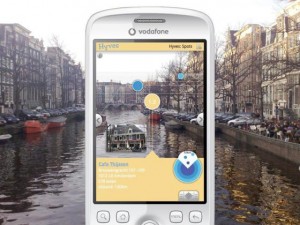 Layar is a Dutch-made program that enables people to leave comments on images captured by their mobile device. The app uses 3D technology to gauge distances as well as the phone’s compass and GPS or cell tower triangulation. Then, computing all this information on the fly, the real image can be geotargeted so that other people can read the comments and post their own.
Layar is a Dutch-made program that enables people to leave comments on images captured by their mobile device. The app uses 3D technology to gauge distances as well as the phone’s compass and GPS or cell tower triangulation. Then, computing all this information on the fly, the real image can be geotargeted so that other people can read the comments and post their own.
People have already demonstrated a desire to share their opinions specifically. Check the level of user engagement in places like Viddler in-play video comments, Yelp reviews and the tips, reviews & crowdsourcing features of contextual location-based apps like FourSquare, Gowalla, BrightKite, Navizon and Waze.
Social captioning seems like a natural evolution of AR. With advanced filtering and administrative control, I can imagine a number of recreational and commercial uses for this kind of application.
- Ratings & reviews Restaurants, bars, local retail
- Visitor attractions City walking tours, Architectural and historical tours, ghost & event tours, sports & convert venues
- Real estate Listings, property details and contact info
- Scavenger hunts For fun & education, geocaching
- Amusement parks Maps, games and awards
- Convention exhibition Product interaction, marketing challenges
- Product testing & consumer feedback Large area or ticket items
- TV/Film Scene caption games, reviews
- Municipal services Emergency response, crime scene investigations, water & gas line mapping
- And more… Education, healthcare, transportation, shipping, traffic & weather, social communities, I could go on.
Layar recently won the Vodafone Mobile Clicks start-up challenge with a €75.000 prize. Here is the presentation they used in their pitch.
To see who is experimenting and applying augmented reality to the real world, visit the AR Consortium.
MLB Dropped the Ball
Have you seen the video of the Phillies dad catching a fly ball? In front of a cheering crowd, he gives it to his toddler daughter who promptly throws it away. It’s so endearing to see his shocked expression, then an “aww shucks” flood of unconditional love for his little girl.

If you’ve been under a rock, go check out the video on Yahoo! Sports.
Chances are, you saw this video within the first 48 hours of its release on YouTube or embedded in a blogs. This event is the hottest piece of content to go viral in recent memory. It’s just so darn cute! This guy is the epitome of “AWESOME DAD”, one I personally can relate to better than the fat dumb dad on any number of sitcoms and spots in the past decade.
It has all the elements of a classic story packed into 30 seconds: plot, character, theme, climax and resolution. A father’s pride, a child’s mistake, forgiveness, reconciliation. It’s so tightly bundled in a beautiful way, it becomes an instant Internet meme. It’s ripe for a super mash-up, something savvy marketers crave.
Unfortunately, the MLB lawyers have trumped all reason and yanked the video from all video-sharing sites, and by proxy, all embedded media like blogs and social networks. Video from their own site is coded in a manner that does not allow it to be played from anywhere except their site. Boom boom pow, this is so 2000 and late!

The MLB completely wasted an opportunity for the MLB to attach its brand to a heart-warming story. Mashable agrees. The MLB could have been recast in celebration of fatherhood or baseball as a family game.
I can already see the 30s spot: the touching video, professionally mastered with compelling V.O. or slide copy. That is fine. But it’s so much more sincere relating to the story when it’s shared among friends in ways they already communicate. Forcing everyone to go to a branded site loses a degree of authenticity.
Presumably, the brilliant legal minds at MLB responded from a flat-policy to defend against future video sharing. I understand the protective need, certainly an open license could be granted in these extraordinary cases. That is the difference between thoughtful leadership and policy management. Instead, the MLB reaction suggests pure greed in a game played by millionaires.
At least the Phillys are playing this up. I hear Dad is getting lots of swag and is making the talk-show circuit. That may seem greedy too, but this kind of PR is organic and altruistic. The team is offering up a wonderful story without the expectation of getting something in return. Big difference.
UK Violence
Need Social and Marketing Talent?
During these difficult economic times, I have many friends seeking work. Please contact me with specific needs or if you are building a future talent base. I can refer people in all areas of marketing:
- Account managers, all levels
Interactive producers
Analysts & strategists
Project & program managers
Content producers
Creative & art directors, all levels
Copywriters
Designers
Flash artists, editors & developers
Web developers
Software engineers, Java, .NET, LAMP
Technical services managers
IT & system administrators
These people are not chaff separated from the wheat. This is an amazing group of smart and experience people swept up in cut-to-the-bone layoffs. Even if you aren’t a hiring manager, please ping me if you are merely aware of openings.
Also, feel free to browse my list of LinkedIn connections, Facebook friends and Twitter followers. I am happy to make introductions.
Obama Wins Viral Video
2008 Presidential Candidates & Interactive Media
I’m a big fan of custom flash units in interactive video advertising. Barbarian Group kicked off the genre with Burger King’s Subserviant Chicken, but EVB & Toy New York helped Office Max push custom advertainment virally with personal content in Elf Yourself.
Two other examples come to mind, Aveaword for BMW Mini UK by Glue London and Carmen Had a Crush On You by JetSet Studios for the Meet the Spartans movie.
As a producer, I like the mix of creative and technical strategy required to pull these off as well as the challenge of tight broadcast integration. These campaigns also glean solid web analytics to help justify ROI. I’ve had fun planning the execution of similar concepts for NASCAR champion Carl Edwards who is building his own personal brand quite well.
Here is the latest one created by MoveOn.org & sent from my longtime friend @NigelPrentice imploring the consequences of my not voting for Obama.
This is a clever execution that is relatively inexpensive because the back-end logic simply handles text & destination email. It doesn’t use pics, video or mobile, all of which yield a richer experience, but exclude less savvy participants. As a result, this simple concept can take off quicker and spread further.
Did you get this in your inbox? I’d be interested in hearing any metrics & market penetration for this campaign. Otherwise, what do you think of the execution?
Post Election Update: Frank Luntz, political analyst and author of Words That Work , says “for the first time ever, this election cycle, more young people got their information from the web than from the print media or television. This has never happened before. It means that YouTube and MySpace and Facebook matter.”
A Case Study in Online Public Relations & Crisis Management
Police arrested a 66 year old woman this week for refusing to pay her $7.45 tab at Waffle House. The story got picked up by Drudge Report, then the broader media and finally through blogs and social media networks.
This is not a bona fide PR crisis, but this situation reflects poorly on Waffle House, a national chain with ~1500 stores. Dumb criminals are entertaining, but reports aren’t clear about why she didn’t (couldn’t?) pay. Many bloggers are finding fault with the restaurant and railing against it. [1, 2, 3, 4, 5, 6, Google Blog Search]
The store manager probably should have discreetly waived the bill, although I can’t imagine they thought the situation would be elevated to national attention. Regardless, this is an opportunity for the company to define it’s relational strategies for crisis management and online consumer interaction.
Background: Waffle House Serves a Broad Base
Full disclosure: I love Waffle House. It’s a brand steeped in Diner Americana invoking the hot black coffee retreat painted by Edward Hopper. The all-day-breakfast menu is working class fuel, from pre-dawn to the deep night-shift. It’s the kind of place comfortable memories are made, from roadtrip pitstop adventures to the nighthawk’s final call.

|

|

|

|

|

|
Waffle House is a cultural icon rich in user-generated content. Click images to see Flickr comments. |
||
Waffle House offers simple food, folksy patrons and they have some of the hardiest working & friendliest servers in the industry. Sitting next to the grill line when the place is slammed, the hot sizzle, greasy smells and barking orders is poetic to a business process nerd like me.
Recent Waffle House PR Challenges & Responses
Waffle House has already faced a series of bad press from unruly customers.
- October 2008 Robberies occur in Texas and Alabama. A fatal shooting Florida is met with calls for boycotts online.
- August 2008 LiveLeak has security video of a brawl complete with racist comments about Waffle House customers. The company should nail whoever is releasing these security videos to the public, although methinks it may have been released by plaintiff litigants who obtained them through the course of Discovery. Unfortunately, the damage is done; the company’s best response is being prepared next time.
- March 2008
 Kid Rock pleaded not guilty for fighting in a Waffle House. I love the company’s response: they invited the star back to a restaurant to greet his fans and raise money for a local homeless shelter. Spokesperson Kelly Thrasher explains the company wanted to “take a negative situation and turn it into a positive situation.”
Kid Rock pleaded not guilty for fighting in a Waffle House. I love the company’s response: they invited the star back to a restaurant to greet his fans and raise money for a local homeless shelter. Spokesperson Kelly Thrasher explains the company wanted to “take a negative situation and turn it into a positive situation.”
Waffle House brand managers should proactively apply this positive philosophy to social media. This recent series of events can be the impetus for a cohesive online PR strategy that touts the brand’s long-standing reputation for good customer service.
“When life gives you lemons, make lemonade!”
Grandma
What Should Waffle House Do?
I recommend a deep dive on some of these general actions.
- Develop an Online Persona
One can expect resistance to social media from a brick-and-mortar diner chain, especially one that doesn’t advertise. Traditional PR might consult with Legal and publicly drop all charges. Or partner with local homeless services nonprofits.
However, consumers have already extended the brand across social networks (more on that below). Blue collar audiences are online, 70% use social media and savvy brands are serving them.
Whataburger is a Southern burger chain with a made-to-order heritage that targets men, 50+. It’s ad agency McGarrah-Jessee drives a polished effort online as well as in direct, outdoor and cool broadcast work reminiscent of my favorite down-home man-it-up Miller High Life spots.
We tailored the BecomeAnEX campaign to help multiple shades of blue-collar audiences. We found a majority of our target already online and eagerly embracing mobile technologies. - Engage Existing Communities
My brief research uncovered a bevy of positive stories, pictures, a Wikipedia article and scores of cult-classic sentiments like this unassuming Waffle House Wedding in Georgia that would have been a hoot to crash. Git ‘er done!
The alt.food.waffle-house Usenet group has 6000 members, there are YouTube videos, 1000s of pics on Flickr, large fan groups on Facebook and Ning and constant tweets on Twitter to name a few.
Once brand managers know where people congregate online, they can enter discussions via PR and interactive advertising. I believe an approachable persona mixed in humurous kitsch and classic PR would be very well received in micromedia formats (@woot comes to mind). - Develop Distinct Strategies for Each Platform
Social media outlets are unique and some communities lend themselves to different business objectives (i.e awareness, response, promotion, revenue, feedback channels, etc). Plan accordingly. - Leverage UGC
Integrate user-generated content into Waffle House web properties. - Attach the Brand to a Quirky Holiday
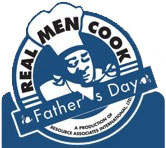 Waffle House already does this to some extent. They are a sponsor of Real Men Cook, a family celebration event hosted on Father’s Day in Atlanta. Waffle House benefits with buzz marketing, product placement and celebrity endorsement.
Waffle House already does this to some extent. They are a sponsor of Real Men Cook, a family celebration event hosted on Father’s Day in Atlanta. Waffle House benefits with buzz marketing, product placement and celebrity endorsement.
The company also celebrates National Waffle Week and hosts the World Waffle Eating Championship that garners press for it’s high-profile speed eaters.
A cheap Quirky Holiday SEM Strategy could generate local press, elevate presence of mind & uptick sales for a couple days on an otherwise off-beat holiday. Eat What You Want Day [May 11] could be fun given their pick-n-choose menu. Other possibilities: Lips Appreciation Day [Mar 16] and No Housework Day [Apr 7]. - Update the “Newsroom”
I’d wager the Waffle House Newsroom got a lot of hits today with this story. And it hasn’t been updated in over two years. Good media relations is critical. - Web Analytics & PR Measurement
Judging by the state of the site, and the apparent lack of a full-time PR manager, I’d wager executives don’t study inbound traffic sources. At one time, Waffle House partnered with Vocus for on-demand news monitoring and measurement. Hopefully company employs basic online monitoring. - Implement a Brandjacking Defense Posture
These are just the kind of one-off stories that instigate a brandjacking that will probably run it’s course in a few days. Even if this case probably will not hurt the brand long-term, why risk it? It appears @wafflehouse has already been brandjacked on Twitter and on Google’s Blogspot.
Using my Social Media Checklist, Waffle House brand managers should snag social media profiles, even if it doesn’t actually engage followers. - Speak to Security Concerns
Customers need to feel safe. Be open about what security measures the company is taking and address flagrant misstatements when they occur. This requires active and passive online brand monitoring. - New Price Points
I’m not privy to current Waffle House pricing strategies, although, I do remember All You Can Eat deals for $3.99 in college! Brands have to be careful about competing on price when a depressed economy eventually recovers. However, this story got traction because of the economy; people will make a connection on price & this lady being unable to afford $7.45. A temporary high-level plan can hedge against public blowback.
Enterprise Strategies in Social Media
While PR focused on external messaging, Waffle House can use social media for internal infrastructure communications.
- Franchise Communications
A few years ago, I got an internal sneak peak at Schlotzsky’s efforts to shore up internal communication among franchisees during a restructuring phase. I’d keep an eye out for anything that supported franchise relations specifically. - Collaborate On Internet Messaging & Brand Identity
Schlotzsky’s also addressed inconsistencies in external messaging, branding and stores across the franchise system, both in traditional and online advertising. From what I can tell, Waffle House is facing similar challenges today. Even after establishing a strict code of branding guidelines, policing and enforcement requires dedicated resources. - Regional Online Marketing & Domainjacking Avoidance
The lack of an online messaging strategy also puts the brand at risk for domainjacking. Franchises are already grabbing their own domain names, which is common when marketplace planning and legal don’t keep pace with technology.
Waffle House should have a unified front in the WaffleHouse.com domain, improve the store locator & offer marketing pages for franchise owners so they can leverage the brand for local promotion. Following this, the company can develop strategies for regional online marketing & mitigate the risk of domainjacking.
Is this case study helpful? What would you suggest to Waffle House executives? Please share your thoughts below!
Update: Read the comments to learn how to win a free cruise. I believe this is the first #freecruise contest held exclusively on Twitter.
Case Study: Effective Online PR by Travel Brands
Working at GSD&M, I got to see some of the cool interactive and broadcast work we did for Norwegian Cruise Line. The creative campaign translates well across print, outdoor & direct and the TV spots have been well-received.
 |
 |
 |
In the social space, Carnival has cruised to the front of the Twitter line. They have a brand evangelist, @CruiseSource, tweeting live from a Carnival cruise that is currently underway. His current bio reads “Your Source for Everything related to Cruising. Live from CCL Destiny 10.16.08.”
CruiseSource.us is a blog about cruising, not Carnival persay. My clients in the travel industry tell me that they enjoy perks from cruise lines and destination resorts in exchange for bookings and promotion. Presumably, that arrangement exists for CruiseSource, and it’s a good way for Carnival to dip their toe in the social ocean.
What is notable about this case is how effectively brand evangelists utilize micromedia to generate buzz and online PR for brands. This is also a good example of small businesses being nimble with social strategy and engagement.
Best Practices in Social Media Strategy & Engagement
CruiseSource is using Twitter to establish themselves as experts in their niche. Rather than just constantly link back to their site, an early mistake they seem to have overcome, they relate with their audience in meaningful ways. Examples:
- They spent weeks building excitement about this cruise.
- They invite cruise-related questions and follow-up with answers.
- They retweet properly.
- They reply and DM properly.
- They suggest cruising for nonprofit fundraising.
- They post cruise specials.
- They post cruise news related to Hurricane Gustav, primarily as a service, but they also attract Twitter search traffic.
- They search Twitter for lead generation. Very smart. They can expand their search by topic, by cruise line, by cruise ship and by destination to find perfect little nuggets like this.
- They listen to tweeters and engage them directly with relevant responses.
- They invite followers & prospective followers to give cruise feedback.
- They tweet about fun activities while aboard the cruise.
- They link to Flickr pics from the cruise ship.
- They are patiently building a Twitter following, maintaining a follow/follower ratio around 4:1.
Apparently their efforts have led a major cruise line to invite CruiseSource to participate on a web 2.0 advisory board. If this is Carnival, then kudos for building a smart partnership and generating inexpensive online PR. As long as CruiseSource maintains an air of industry promotion and authentic human interaction, Carnival will benefit from the company’s peer recommendations.
For any travel brand, I suggest a few more tips in establishing a genuine social presence online.
- Be more personable. CruiseSource has found a voice on Twitter and its blog, but it still hides behind the company name on all posts. Even using a first name (Tucker?) would cut through informality and lend credibility to their recommendation.
- Browse Peter Kim’s list of social media marketing examples for inspiration. Carnival Connections already made his list with it’s community forum, but the site entry is weighted heavily toward sales.
- Remain Authentic. Tyler Banfield offers good tips on authentic promotion.
I’m interested to see what travel brands develop on other social platforms, both in external marketing and within the company’s internal organization of staff, partners and sales channels.
Review: GoDaddy
Interactive Producers are often tasked with domain name registration and management on interactive campaigns. To this end, I offer a Domain Checklist to help producers and brand domainers obtain domain names from the registrar provider. Let’s look at the pros and cons of GoDaddy.
Reasons to Use GoDaddy
Search domains
Their whois search is good at recommending similar domains. This is helpful during domain selection in the campaign’s creative strategy phase.
Cheap registration
GoDaddy has always offered the most competitive registration rates for commercial domains. Be sure to get a significant discount using the GoDaddy promo codes from the Live Codes blog. This can be a significant savings the client will appreciate, especially when registering hundreds of domains purely in defense of domainjacking.
Smooth domain administration
GoDaddy offers one of the easiest control panels in the industry for domain renewals, DNS changes, domain transfers and bulk administration. Domainers can also lock accounts and plan auto-renewals for up to 10 years.
Wide TLD variety
GoDaddy allows registration with a large number of top level domains, including some TLDs reserved for country codes and sponsored entities. Use the convenience of a single source.
Flexible terms on hosting
The GoDaddy hosting model is engineered for a high volume of low traffic sites. I once produced a campaign that generated so much traffic on GoDaddy servers, they had to temporarily take our site offline to move it to a different production environment. We got a surprise series of bills for the burstable load, our hosting bill jumped from $200 to nearly $20,000!
Despite our success in marketing, I negotiated a significant price reduction. GoDaddy graciously agreed to accept a fraction of the cost, and they allowed us to move the campaign to a host provider better equipped to scale rapidly during traffic crunches.
You can reach a human being
Unlike many smaller registrars, you can talk to a real people at GoDaddy. Call (480) 505-8877. This can be crucial when dealing with odd situations like sponsored TLDs, renewals, transfers, emergency DNS administration or chasing down account access due to poor management during campaign staff turnover.
Proactive customer service
Update I got a brief voicemail from GoDaddy just checking in to make sure everything is a-ok. Nice touch!
Reasons to Avoid GoDaddy
Excessive Upselling During Registration
I don’t even ask my most savvy brand managers to suffer the endless stream of GoDaddy upselling during the registration. My campaigns rarely need the privacy, promotional or hosting add-ons. It can be tricky navigating the registration process, especially by domain owners that aren’t sure about what services are needed.
Enough with Old Man Perv Thing
Bob Parsons is a great example of a corporate video blog from a high-profile CEO. It’s a good mix of personality, education and inspiration for domainers.
However, his boorish persona steeped in adolescence and keenly expressed in the company’s sexually charged Superbowl ads is kinda creepy (he really should consider leaving Guyland). Judging by his fan comments, he has managed to build a cult following a la other web celebs. But is his regression really such a feat in the shadow of Hugh Hefner? I’m just sayin’. Have some fun, but think a little more Richard Branson or Larry Ellison and less Tila Tequila.

Deconstructing Personal Twitter Feeds to Help Communication
Without being privy to formal Twitter usability studies, I’d wager most people rarely browse their tweet timeline beyond the first page. For those of us who follow hundreds and thousands of tweeters, we miss the vast majority of tweets in our network. It also means that only the most frequent tweeters have a chance of being heard by their followers.
How to hear your friends on Twitter
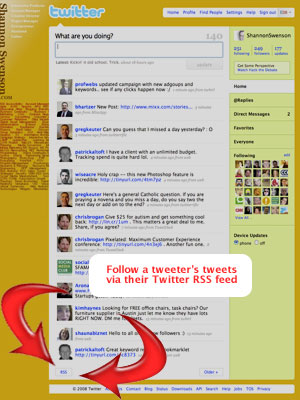 When I’m in a consumer mode, I often click on individual tweeters to read their last series of posts. I gravitate toward different people depending on what mood/topic I’m interested in at the time.
When I’m in a consumer mode, I often click on individual tweeters to read their last series of posts. I gravitate toward different people depending on what mood/topic I’m interested in at the time.
My friend who is new to Twitter asks, “How can I push my friend’s tweets to me?” Easy. Scroll to the bottom of a profile and subscribe to the RSS feed. You will see their tweets in your reader.
You may have select tweeters of whom you’d like to read everything they say, so subscribe to their RSS feeds. Note, when someone deletes a tweet from their timeline, it still appears in their RSS feed like Google Reader or Facebook. People in this category might include:
- News feeds
- Family & close friends
- Thought leaders, trend watchers
- Twitter HR: Coworkers, staff, employees, applicants
- Prospective tenants
- Online reputation management
- Legal forensics
- Private accounts for project collaboration
- Companies, products, sports teams, celebrities
- Others? Leave a comment below!
How to be heard by your friends on Twitter
Use @name replies so tweets about them will show up in their Replies list. I’ve found people tend to favorite these tweets more often (I do too) and people are more apt to reply back. Be sure to put the @reply at the beginning of your tweet, otherwise it will not appear in their Replies list (Twitter should fix this).
I also direct message (DM) people with increasing frequency. By default, Twitter sends them an email to their preferred email account and it lands in their Direct Messages queue. Good uses for @replies and DMs are:
- Expressing appreciation for new follows
- Conventions, tweet-ups
- To make an introduction
- Apply for jobs w/ Twitter-savvy recruiters like @kimhaynes
- Ping a friend’s mobile device (also use the Nudge feature)
- Quick & pithy emails
- Top of mind awareness
- Lead generation
Is this helpful? Please talk back with a comment or tweet me with an @reply or DM 🙂
Domain Management is a Function of Brand Stewardship
In my experience on campaigns large and small, domain management is too often been an afterthought. This is unfortunate because proper domain planning can really help the success of a campaign just as a lack of planning can harm a campaign. Domain stewardship isn’t difficult and it attaches naturally to the creative process.
Online Brand Stewards Should Control Domains
Who is the proper steward of a brand online? The client? The ad agency? The interactive agency? There are many POVs about who “owns” a brand online.
As marketing stretches into corporate strategy, sales, service and support, it becomes more than visual identity and messaging in traditional media. Arguably, some measure of brand ownership actually transfers to the public because of the distributed self-investment of social media.
Online brand stewardship is currently relative to a blend of talent, resources, capabilities, experience and expertise within a particular client-agency partnership. Depending on the mix, brand control would clearly fall into one camp, or it might be a joint responsibility with each party assuming specific roles.
Regardless of who stewards the brand online, one party should assume ownership of the brand’s roster of domains.
Domain Management for Small Businesses
When I started my own web development company in 1997, I used to register domains for my clients. I stopped this practice by 2000 because I found it to be a taxing deviation from my primary service. I spent too much time tracking down old clients, getting renewal approvals and collecting money for domains I paid for, but didn’t own.
I also wasted a lot of time tracking down old web developers and hosting partners who had registered my client’s name in their own name. In most cases, I’d have to convince a dejected former partner to hand me the domain keys. In some cases I encountered old vendors who wouldn’t release the domain without receiving payment on an unrelated service, a form of blackmail domainjacking. Consequently, I registered domains on behalf of my clients using their credit cards.
Today, small hosting companies and web developers can turn to broad suites of automated hosting tools to help them run their business. These tools handle everything from lead gen to automated POS, server administration, and of course, discounted domain registration.
Still, I encounter considerable domain management risk all too frequently. Registration and administration is abdicated to the most technically savvy people on the team.
Good domain management involves more strategy than production. Many domain managers are intimidated by the technicalities of domaining, but they really just need to approve a clear domain strategy. The plan can easily be executed by an interactive producer or brand domainer.
Online Brand Stewardship Requires Proper Domain Management
As interactive media matures, I foresee a greater dependency on a unique service discipline: the Brand Domainer. This person or company would monitor domaining trends and would consult with agencies and clients on procurement. Domaining and brand registration is a critical duty in interactive campaigns, yet this responsibility is currently dispersed between IT, marketing & production groups and across client, agency, developer and hosting companies.
The Brand Domainer fulfills these roles:
- Domain Procurement & Maintenance
Stakes out and maintains Registrar partnerships for generic, sponsored and country code TLD registration & transfers. Marks timely payments to avoid downtime and tightly controls DNS administration across all brands.
The idea of a “Digital Safe Deposit” can be useful for interactive ad campaigns, especially flights across multiple platforms (social media, SaaS, Web 2.0, DNS, hosting, etc). With dispersed talent & high turnover between client/agency/interactive/partner companies, account authentication & digital assets are at risk. - Domain Consultation & Recommendations
Make recommendations on domain names based on availability, creative work, domaining budget and risk of domainjacking threat. - Social Media Consultation & Profile Registration
Make recommendations on social media platforms based on creative work and risk of domainjacking threat. Register profiles and maintain a master list of access points for brand agents and community managers. - Domaining Budget
Forecast and maintain domain registration budgets based on procurement plan and length of agreements. - Brand Monitoring & Policing
Use RSS & monitoring tools like Google Blog Search, Radian6, TweetBeep and UsernameCheck.com to passively intercept threats. Actively query and patrol search engines and popular social media platforms for brand abuses.
Protectors of very large brands already pursue brand infringements, at least passively. I have a good friend who took his site down after receiving a Cease and Desist letter from McDonalds. This was for a .nl Netherlands domain that simply began with “Mc.” Either some poor legal IT intern found his obscure domain while scouring the web through a dictionary search (black helicopter active), or his online brand promotion was so successful that he sprang up on a staffer’s radar (passive interception)
Note, brand monitoring describes preventative activities for brandjacking and domainjacking. This is distinct from listening, measuring and analyzing social media for ROI, strategy or engagement, more accurately defined as Analytics. - Domain Dispute Resolution
Command a working knowledge of the ICANN Dispute Resolution Policy; a domainjacking mandates a rapid response. Refer to the Domainjacking Primer for advise on what to do if you’ve been domainjacked. - Social Media Dispute Resolution
Most social media platforms currently do not publish dispute resolution policies. Brands with trademarks and service marks likely have a case for account termination or transfer. However, at this time, prevention through pre-launch registrations is recommended. - Legal Liaison
Maintain awareness of legislation like the Snowe Bill that impacts the domaining industry. Follow dispute resolution briefs such as the Fairwinds’ list of brandsucks complaints.
Brand Domaining As a Vendor Solution
If anyone is poised to successfully launch this new kind of service, it’d be a large ICANN registrar like GoDaddy, Register.com or Network Solutions. A smaller registrar might also consider this play as a means of generating properties through large bulk registrations.
Interactive shops or hosting companies could provide brand domaining as a flat pass-through cost to large and small agencies that are stretching interactive resources. I can also conceive of a new SaaS company carving a lucrative niche practice in this space. Profilactic.com is a social media agreggator/lifestreaming service that promised to help people with “identity crisis.”
In either case, the should become an Accredited ICANN Registrar capable of registering its own Top Level Domains (TLDs). This would make the registration of domains less expensive so campaigns could acquire massive domain batches.
Domain management is an important part of brand stewardship; I think clients and agencies would appreciate the peace of mind from a partner that made this a painless component of their interactive campaigns.
All Your Domainjack Are Belong To Us
My Personal Domainjacking Experience
As part of my Domainjacking Primer, I want to share my own experiences in “gettin’ punk’d” by a domainjacker. Hopefully I can help other online brand managers avoid or respond to this kind situation.
The Dastardly Domain Thief
i worked on a national campaign that invested heavily in product development, brand identity and advertising production for months before the official launch. We attracted millions of impressions via PR, TV, radio, direct and online media. Everyone considered the campaign a success.
Unfortunately, within days of launching the campaign, a domain squatter managed to register an odd non-premium generic domain. This person slapped a fake website together to deliberately confuse our target for their own profit. Operating from a foreign country, they sold a knock-off product using our brand equity.
To make matters worse, they launched their own Adwords campaign and directly competed in search media. Our trademarked brand and its keyword variants initially had low usage, so the squatter could snag niche keyword inventory at a very low CPM. However, their “competitive” keyword grab boosted the inventory value, complicated our SEO efforts and made SEM more expensive for our campaign.
By capturing a fraction of our search traffic, they clearly intended to profit from PPC AdSense revenue given the ads plastered throughout their site. In no time flat, we faced public confusion and brand dilution from someone piggybacking our large investment and months of hard work.
Domainjacking Mandates a Swift Response
 Fortunately, we responded so quickly that the brand ultimately only suffered mere annoyance. Working through cease and desist letters, we procured the rapid cooperation of the squatter’s registrar and hosting company. We reclaimed rightful domain ownership and even enjoyed brief AdSense exposure at the squatter’s expense.
Fortunately, we responded so quickly that the brand ultimately only suffered mere annoyance. Working through cease and desist letters, we procured the rapid cooperation of the squatter’s registrar and hosting company. We reclaimed rightful domain ownership and even enjoyed brief AdSense exposure at the squatter’s expense.
Following this episode, we developed a comprehensive domain management policy that purchases large blocks of domains. There is now tighter DNS coordination between agency account management and client IT management in the run-up to new campaign launches. And following a campaign launch, the agency and client actively patrol for new infringements against their brands.
Avoid Domainjacking with Proper Planning
In addition to this overt case of domainjacking, I have encountered all kinds of problems from poor domain stewardship. I’ve had to wrest DNS info from former web developers and hosting companies, help track down lost passwords from old employees and rescue domains from botched international transfers. Each of these cases could have been avoided.
These experiences motivated me to write this series on brand stewardship and domainjacking avoidance. Today, I utilize several tools on ad campaigns to help with domain registration, DNS account management, social media profile management as well as engagement analytics.
Speaking of brandjacking, here is the “ALL YOUR BASE ARE BELONG TO US” vid, a 4-minute mash-up of old viral memes. Lots of mileage from this mix-tape.
Best Practices in Domain Management
Having produced scores of integrated interactive campaigns, I have seen unexpected problems arise from improper domain and social media account management.
I want to share my experience and offer advice on domainjacking, a risk that can be particularly detrimental to brands.
What is Domainjacking?
Jump to a section below
What is Domainjacking?
Types of Domainjacking
What Domainjacking Is Not
How to Defend Against Domainjacking
How to Respond to a DomainjackingDomainjacking* is a bold type of brandjacking where domainjackers co-opt a brand’s identity and goodwill in bad faith at the point of domain registration. Domainjackers aim to steal traffic for personal profit or to smear a brand. They use search engine marketing and organic search results to generate profit in the form of PPC ad revenue and/or sales of similar products and services.
Unlike phishing scams that prey on victims through broadcast spam email, domainjackers build websites using branded domain names. Using SEM/SEO, brandjacked social media profiles, and conceivably through phishing, they drive traffic to their illicit sites.
Consequently, search engines are constantly adjusting their algorythms to avoid driving traffic to illegitimate domains. Social media platforms will need to implement Dispute Resolution Policies as brandjacking becomes more prevalent and as social media becomes more important to brands.
Types of Domainjacking
Here are a few examples of domainjacking, either by malicious parties or brand stewardship incompetence. Some tactics are illegal, some may not have a legal precedence.
- Alternate TLD Registrations
Many interactive campaigns only register the most popular top level domains like .com, .org and .net. A domainjacker often sweeps in to buy other TLDs like .info, .biz as well as country code TLDs like .us and .uk. - Similar Names
Domainjackers may register domain misspellings, similar spellings or phrases with the brand name embedded. - Domain Disputes
Small business marketing services companies like web developers, graphic designers and former employees have been known to hijack a domain they registered on behalf of their brand client for nonpayment of services. - “BrandSucks.com” Gripe Sites
Vindictive and aggrieved customers may register a brandsucks site in order to voice their complaint or publicly trash a brand. In these cases, brand managers have to file official UDRP complaints with ICANN in order to affect site termination or transfer.
Internet strategy consulting firm Fairwinds Partners maintains a list of UDRP brandsucks complaints, their outcomes and ICANN’s decision. Note many complaints did not rule in favor of the brand complainant. (Hat tip to IPKat’s Law Blog for links and opinions in this area.) - Outright Domain Theft
Domainjackers may use a variety of methods to acquire access to a brand’s registrar account. With this information, a domainjacker could transfer ownership or temporarily redirect traffic to an alternate web server.
What Domainjacking Is Not
When trying to define what something is, it’s helpful to define what it is not.
- Domaining
Domaining is a multifaceted multibillion dollar industry involving domain sales, management, brokering, auctions and link generation. One can find successful “domainers” in the “domainersphere” who’ve profited from legitimate domain trading. - Legitimate Domain Ownership
Domainjacking is not the legitimate transfer of domain ownership nor is it the legitimate aquisition of a domain following its term expiration. “Domain squatters” utilize software to grab domains when they expire and brand managers may be forced to bid on those domains in the open marketplace if they cannot demonstrate bad faith on behalf of the new registrant. - Lost Registrar Passwords
In order to prevent domainjacking, registrars have numerous checks in place to verify domain administrators are who they say they are. - Registrar Parking
Registrars can park domains on their own servers for nonpayment. - Phishing
Phishing is a malicious type of brandjacking that preys on customers of a brand. This tactic is usually executed via spam email that asks the recipient to click on a bogus link to enter personal account information. The fake landing page often has branded subdomains and a similar visual identity intended to confuse and deceive.
How to Defend Against Domainjacking
To the extent a team can anticipate threats, domainjacking is largely avoidable.
- Don’t be cheap
Domain registration is a nominal cost of a campaign, but it can be a significant line item. Be prepared to explain the cost of not properly managing domain registrations in terms of harm to the brand, lost revenues, lost engagement opportunities, legal fees, misplaced resources, etc. - Mark Your Brand
Where appropriate, get a trade or service mark on your brand. This won’t prevent DNS registration, but it will help support registrar domain disuptes and convincing hosting companies to comply with ceast and desist requests. - Perform a Simple Risk Analysis
Start a list of domains ranked by high, moderate and low risk threats of domainjacking. This list would be considerate of the project’s domaining budget, media plan and forecasted impact. Popular brands should register all TLDs appropriate for a campaign. Read my Domain Checklist For Interactive Campaigns when planning & registering domains. - Avoid Social Media Brandjacking
Invest time to register brands with popular social media & micromedia account profiles. Jeremy offers an excellent list of Brands that got Punk’d by Social Media. Follow my Social Media Checklist For Interactive Campaigns as a minimal social media strategy. - Register with a Generic DNS Admin
When registering a domain, use a generic email account like [email protected]. Not only does this help control privacy of domain ownership, but you also remove your dependency on individual staff. When the producer or DNS manager leaves your company, you don’t need to go searching for passwords or log into your registrars to change all the contact. You can simply auto-forward the generic DNS admin accounts to a new account. Take care not to jeapordize security in this handoff. - Manage Domain Passwords
This duty usually falls into the realm of the Interactive Producer, however, online brand stewards should take care to safeguard this content from the risk of threat. Resource managers may also consider assigning all domaining duties to a single Brand Domainer. - Long Registration Periods and Auto-renewals
All registrars allow domain managers to registrar domains for extended periods of time. This can actually help SEO because search engines trust long-term domains more than those nearing expiration. Set accounts to auto-renew domains to prevent unintended expiration. Be sure to keep credit card info up to date with the registrar. - Lock Registrar Accounts
Most registrars now allow account managers to lock the domain accounts to prevent accidental account changes. - Register Your Own Brandsucks Gripe Site
“Sucks” and “stinks” are two common pejoratives in brand bashing. BrandChannel distributes a whitepaper on managing the destructive potential of brandsucks: The Power of Internet Gripe Sites. One notable example is the film theater chain Loews. The registered LoewsSucks.com and use the site as a customer feedback channel with its Guest Satisfaction Survey. Fairwinds Partners maintains a list of 100s of brands that have registered their own brandsucks domain name.
How to Respond to a Domainjacking
If you’ve been domainjacked, you need to mobilize your team and respond swiftly to limit damage to your brand. Here are a list of actions.
- Know Your Enemy
Perform a Whois search to determine who registered the domain and where it is hosted. Note, the domainjacker may have made this info private to thwart your effort, but you will be able to determine their registrar and the IP address of the host server. - File a UDPR with the ICANN Registrar
ICANN publishes their Uniform Domain-Name Dispute-Reolution Policy or UDPR that is followed by all registrars. Here are considerations that help complainants win a favorable ruling.
Trademark and Service Mark
Demonstrate use of, or demonstrable preparations to use, the domain name in connection with a bona fide offering of goods or services. Note, weak and nonexistent trademark claims, aka reverse domainjacking, can harm a brand.
Commonly Known
Demonstrate being commonly known by the domain name, even if you never acquired trademark or service mark rights.
Noncommercial Fair Use
Demonstrate how the domainjacking either a) intends to mislead or divert customers, b) tarnishes the trademark or service mark or c) is not a noncommercial or fair use of the domain name.
Even with an airtight claim and amid a customer service crisis, Panix, the oldest ISP in New York, faced crippling battles with MelbourneIT and Verisign when their email traffic got domainjacked. - Lawyerup and Counterpunch
Attorney jokes are to Americans as Aggie jokes are Longhorns, but this is the time you want aggressive legal counsel in the are of Intellectual Property rights and domain management. - Attack on Multiple Fronts Simultaneously
Send Cease and Desist letters to the registrant and to the hosting company. The sites are commonly self-hosted in a foreign country, so be sure to follow the ICANN domain dispute process and contact the hosting company directly.
In my next article, I will share my own own experiences on domainjacking.
Footnotes
* I love the English language because we can easily meld words to form new phrases without disrupting transmission. I prefer “domainjacking” over “domain jacking” or “domain-jacking” because a precendent has been set with “carjacking.” (OT: I once got carjacked in Oak Cliff near Dallas; ask me about it sometime.)
And for you SEO and domaining ninjas, I hope you appreciate my not-so-subtle effort to capture some alternative spelling traffic! In case your wondering, and so that I might mention the keyword just one more time, here are some domainjack conjugates (and their current Google results). I’ll spare you the H1 tag wraps 🙂
Domainjacks (24)
Domainjacking (588)
Domainjacker (4)
Domainjackers (4)
Domainjacked (382)
Domainjackgate (1 result YES! I WIN!)
I’m claiming this one before the media constructs a scandalous ‘gate’ suffix!
Online Brand Management: Secure These Profiles
Clients, agencies and interactive production shops can use this checklist when registering brands with social networks & web 2.0 platforms for a specific campaign. This list is helpful for domain planning and for domainjacking avoidance.
UsernameCheck.com is a helpful utility that scans social tools to monitor domainjacking. Brand managers may elect to register brands with tools, even if they are not initially used in the campaign. Services like Profilactic.com can help with social media aggregation
» Last Modified December 10, 2008
» # of Platforms 93
Micromedia, Status
| Platform | Brand URL | |
| * | Brightkite | http://brightkite.com/people/brand/ |
| * | Friendfeed | http://friendfeed.com/brand |
| Hellotxt | http://hellotxt.com/user/brand | |
| Hexday | http://hexday.com/users/namecheck/brand | |
| Identica | http://identi.ca/brand | |
| Jaiku | http://brand.jaiku.com/ | |
| Koornk | http://www.koornk.com/user/brand/ | |
| Kwippy | http://www.kwippy.com/brand/ | |
| Meemi | http://meemi.com/brand | |
| * | Plurk | http://www.plurk.com/user/brand |
| Pownce | http://pownce.com/brand/ | |
| Rejaw | http://rejaw.com/brand | |
| * | http://twitter.com/brand |
Social Bookmarking, Tagging, News, Trends, Lists
| Platform | Brand URL | |
| Delicious | http://del.icio.us/brand | |
| Digg | http://digg.com/users/brand | |
| Ffffound | http://ffffound.com/home/brand/found/ | |
| Good Reads | http://www.goodreads.com/profile/shannonswenson | |
| Ilike | http://www.ilike.com/user/brand | |
| ILikeLoveIt | http://www.iliketotallyloveit.com/user/brand | |
| Isfingawesome | http://brand.isfuckingaweso.me/ | |
| Lastfm | http://www.last.fm/user/brand | |
| Lifehacker | http://lifehacker.com/people/brand/ | |
| Magnolia | http://ma.gnolia.com/people/brand | |
| Mixx | http://www.mixx.com/users/brand | |
| PlugFM | http://www.plugim.com/user/brand/ | |
| http://www.reddit.com/user/brand/ | ||
| Revver | http://revver.com/u/revver/ | |
| SocialMedian | http://socialmedian.com/brand | |
| Sphinn | http://sphinn.com/user/view/profile/shannonswenson | |
| Stumbleupon | http://brand.stumbleupon.com/ | |
| Technorati | http://technorati.com/people/technorati/brand | |
| Tumblr | http://brand.tumblr.com/ | |
| Yotify | http://yotify.com/a/profile.aspx?u=brand |
Blogging, Self Publication, Mashups, Aggregators
| Platform | Brand URL | |
| Bebo | http://www.brand.bebo.com/ | |
| Behance | http://www.behance.net/brand | |
| * | Blogger / Blogspot | http://brand.blogspot.com |
| Livejournal | http://brand.livejournal.com | |
| * | Posterous | http://brand.posterous.com |
| Profilactic.com | http://www.profilactic.com/mashup/brand/ | |
| Squarespace | http://shannonswenson.squarespace.com | |
| Suprglu | http://brand.suprglu.com | |
| Typepad | http://brand.typepad.com | |
| Utterli | http://www.utterli.com/brand/ | |
| Virb | http://www.virb.com/brand | |
| Vox | http://brand.vox.com/ | |
| Weebly | http://brand.weebly.com/ | |
| * | WordPress | http://brand.wordpress.com |
| Xanga | http://www.xanga.com/brand | |
| Yoono | http://memo.yoono.com/buzzlog/buzz.jsp?login=brand |
Rich Media, Video/Photo Sharing, Podcast Networks
| Platform | Brand URL | |
| 12seconds | http://12seconds.tv/channel/brand | |
| Dailymotion | http://www.dailymotion.com/brand | |
| Favtape | http://favtape.com/brand | |
| * | Flickr Photostream | http://www.flickr.com/photos/brand/ |
| * | Flickr Profile | http://www.flickr.com/people/brand/ |
| Funnyordie | http://www.funnyordie.com/brand | |
| Imageshack | http://profile.imageshack.us/user/brand/ | |
| Jumpcut | http://www.jumpcut.com/brand | |
| Picasa | http://picasaweb.google.com/brand | |
| Smugmug | http://brand.smugmug.com/ | |
| Viddler | http://www.viddler.com/brand | |
| Vimeo | http://vimeo.com/brand | |
| Visualizeus | http://vi.sualize.us/brand | |
| * | Youtube | http://www.youtube.com/brand |
| Zooomr | http://www.zooomr.com/people/brand |
Social Gaming
| Platform | Brand URL | |
| Xbox-live | http://brand.mygamercard.net/ |
Social Communities, Networking
| Platform | Brand URL | |
| Bakespace | http://bakespace.com/members/profile/brand/brandid/ | |
| Colourlovers | http://www.colourlovers.com/lover/brand | |
| Corkd | http://corkd.com/people/brand | |
| Diigo | http://www.diigo.com/profile/brand | |
| Ecademy | http://www.ecademy.com/user/brand | |
| * | http://www.facebook.com/pages/brand/brand_id | |
| Gather | http://brand.gather.com | |
| * | Grou.ps | http://brand.grou.ps |
| Hi5 | http://brand.hi5.com/ | |
| HubPages | http://hubpages.com/hub/brand | |
| http://linkedin.com/in/brand | ||
| Multiply | http://brand.multiply.com/ | |
| * | Myspace | http://www.myspace.com/brand |
| * | MyBlogLog | http://www.mybloglog.com/buzz/members/brand |
| * | MyBlogLog | http://www.mybloglog.com/buzz/community/brand |
| * | Ning | http://brand.ning.com |
| Pandora | http://www.pandora.com/people/brand | |
| Perfect Networker | http://www.perfectnetworker.com/network/brand/ | |
| * | SocialGo | http://brand.socialgo.com |
Enterprise, E-commerce, Tools, Utilities
| Platform | Brand URL | |
| ChipIn | http://brand.chipin.com/ | |
| * | Disqus | http://brand.disqus.com |
| Ebay | http://myworld.ebay.com/brand/ | |
| Etsy | http://brand.etsy.com/ | |
| GetSatisfaction | http://getsatisfaction.com/people/brand | |
| * | Feedburner | http://feeds.feedburner.com/brand |
| * | [email protected] | |
| * | Hotmail | [email protected] |
| Tipjoy | http://tipjoy.com/u/brand/ | |
| Tinyurl | http://tinyurl.com/brand | |
| * | Yahoo | http://profiles.yahoo.com/brand |
| Zillow | http://www.zillow.com/profile/brand |
* = High risk for domainjacking. Register these accounts at minimum for all campaigns. Certain types of campaigns may require accounts on other/all platforms.
Was this post helpful? Have any additions? Don’t agree with my taxonomy? I wanna know. Please talk back & leave a comment!
Online Brand Management: Secure These Domains
Clients, agencies and interactive production shops can use this this TLD checklist when registering top level domains for a specific campaign. This list is helpful for domain planning and for domainjacking avoidance.
» Last Modified October 6, 2008
» # of Platforms 81
Generic TLDs
Nearly all campaigns merit registration of all Generic TLDs.
.biz
.com
.info
.name
.net
.org
.pro
Sponsored TLDs
Registration of these domains is limited to specific conditions.
.aero
.asia
.cat
.coop
.edu
.gov
.int
.jobs
.mil
.mobi
.museum
.tel
.travel
Commercial, Vanity and Domain Hack ccTLDs
Brands may utilize some of these popular country code TLDs. They may also build domain hacks that combine subdomain and TLDs for clever or shorter domains (i.e. del.icio.us).
.ad – advertising
.ag – agriculture
.am – AM radio, audio, podcasts, domain hacks
.be – domain hacks
.cc – carbon copy
.cd – Audio, podcasts, file sharing
.dj – Audio, podcasts, file sharing
.fm – FM radio, audio, podcasts
.gg – social gaming, gambling (gg = good game)
.im – instant messaging, domain hacks
.in – Internet, domain hacks
.it – Internet, domain hacks
.je – “You” in Dutch and “I” in French
.la – Los Angeles, domain hacks
.li – Long Island, domain hacks
.lv – Las Vegas, love
.md – medical doctor
.me – individuals
.ms – Microsoft projects
.mu – music, audio
.nu – “New” in English, “Now” in Dutch
.sc – source
.st – street
.to – Toronto, domain hacks
.tv – broadcast, entertainment, online video
.ws – website
.vu – “View” in English, online video
.vg – video games, advertainment
TLD References
IANA
ICANN
Historical TLDs
Generic TLDs (gTLDs)
Sponsored TLDs (sTLDs)
Country Code TLDs (ccTLDs)
List of Current IANA TLDs
TWIP Bulletin 9/27/2008
The Weekly Interactive Producer Bulletin
September 21, 2008 to September 27, 2008
# 7Wario Land Shake It!
The Twittersphere lit up with this week linking to this clever YouTube channel.
http://www.youtube.com/experiencewii
# 6Lizzer Simplifies Content Aggregation
Lizzer has a private beta for its online publishing tool. Community managers, bloggers, extranet and web publishers can search Lizzer for links, pics and videos by subject and get simple embedding code. Check the demo at Lizzer.com
# 5Moximity Delivers Location-based Ads
Moximity delivers location-based offers through social media on mobile devices.
I used to co-office with the founders of Wayport and this was the original idea behind their network of hospitality & travel center hotspots. I guess they were just 10 years ahead of their time.
# 4UGC Helps Opex Scaling
@deckermarketing Posted an excellent article on user-generated content in terms of its operation expense scaling – a value proposition that is sure to please CFOs in tough economic times.
# 3Hack the Debate
TV & social media continue to converge. Current TV & Twitter partnered to show real-time feedback during the debates. Jeremiah found it distracting.
# 2Rapid Response Interactive Media
Alan Edget (@ACEdge) is an F500 social media strategist behind those clever FreeCreditReport.com ads (I love these; their funny & work well on TV & radio). He blogs about his attempt to create an algorithm that measures ROI on interactive media placement. The goal is to be able to rapidly respond to the market & change placements, kind of like options trading.
# 1 First Day of Autumn 2008
I see a few SEO companies are leveraging Google’s logo changes for fresh untargeted traffic. This is a clever ploy to prove their SEO mettle and generate a little buzz. Free and easy, this tactic is bound to become a meme. I built upon their accomplishments to develop the Quirky Holiday SEM Strategy.
BONUSDid you know that Google saved all their holiday and event logos for posterity? I love the preservation of campaigns. It’s a good practice for entertainment, history & long-tail traffic.
How Brands Can Generate Big Awareness During Odd Holidays
Last week, as the world celebrated another Talk Like a Pirate Day, I thought of a slick SEM trick: Buy quirky holiday names for the sole purpose of brand awareness. Quirky holiday inventory has temporary demand spikes and low-competitive rates. This might be good opportunities to align your brand with fun, off-beat culture news and catch new visitors during idle leisure time browsing the net.
Retailers have long used White Sale strategies to dump excessive inventory and to gain a temporary competitive advantage. The Quirky Holiday SEM strategy is slightly different than a White Sale. Rather than promote a branded self-made sales event, Quirky Holiday SEM leverages universal interest and PR surrounding unusual events to generate brand awareness. The strategy lends itself to retail, but could be used for any type of brand promotion.
Awareness and low cost can justify the ROI of a Quirky Holiday SEM media plan. Traffic is not targeted, so click-throughs are a bonus, especially since keyword inventory would be relatively inexpensive.
Ideas for Quirky Holiday SEM Campaigns
Here are just a few of the strange, funny and odd holidays where corporate brands, campaigns and associations could apply this strategy.
- Bifocals At The Monitor Liberation Day
December 1 Lenscrafters, eye doctors & Lasik surgeons, ergonomic companies, nonprofits for the prevention of eyestrain, monitor fatigue, eyesight health education & disease prevention, elder care. - Bathtub Party Day
December 5 Kohler, Whirlpool re-modelers (bathfitter.com already has a placement), plumbing companies, design centers, home builders, destination spas. - National Inane Answering Message Day
January 30 Manufacturers like Panasonic, Sony, Nokia, Samsung & Motorola, online retailers, VoIP carries Skype and Vonage, cable carriers, cell phone service providers, mobile marketing. - First Day of Autumn 2008
September 22 SEO companies are already leveraging Google’s holiday and event logos for fresh non targeted traffic. What a clever ploy to generate a little buzz and new unique visits against an odd keyword. So far, these are simple organic SEO results, but SEM could easily apply.
Hat tip to @PatrikAltoff who managed to attract hundreds of “autumn 08” visitors to Blogstorm on Sep 22, 2008.

- Any Quirky Holiday
Hallmark could actually target traffic with Quirky Holiday SEM, assuming they had matching merchandise. A smaller print card company or e-card service could generate a significant portion of its revenue on this SEM traffic.
What Quirky Holiday SEM Strategies can you imagine? Share them below!
How the Marines Can Help Your Online Community
As a member of the Sam Houston Rifles, we had to memorize and practice the 11 Leadership Principles and 14 Leadership Traits taught by the United States Marine Corps. These principles and traits merit occasional reflection by business & online community leaders.
The Center for Leadership Studies at the USAF Air War College posts a brief analysis of these virtues and offers suggestions for personal development and team improvement in each area.
 11 Leadership Principles of the USMC
11 Leadership Principles of the USMC
 14 Leadership Traits of the USMC
14 Leadership Traits of the USMC
The 11 Leadership Principles
- Know yourself and seek self-improvement.
- Be technically and tactically proficient.
- Develop a sense of responsibility among your subordinates.
- Make sound and timely decisions.
- Set the example.
- Know your Marines and look out for their welfare.
- Keep your Marines informed.
- Seek responsibility and take responsibility for your actions.
- Ensure assigned tasks are understood, supervised, and accomplished.
- Train your Marines as a team.
- Employ your command in accordance with its capabilities.
The 14 Leadership Traits
The acronym JJDIDTIEBUCKLE helped us memorize the 14 Leadership Traits.
- Judgement The ability to weigh facts and possible solutions on which to base sound decisions.
- Justice Giving reward and punishment according to merits of the case in question. The ability to administer a system of rewards and punishments impartially and consistently.
- Dependability The certainty of proper performance of duty.
- Integrity Uprightness of character and soundness of moral principles; includes the qualities of truthfulness and honesty.
- Decisiveness Ability to make decisions promptly and to announce them in clear, forceful manner.
- Tact The ability to deal with others without creating offense.
- Initiative Taking action in the absence of orders.
- Endurance The mental and physical stamina measured by the ability to withstand pain, fatigue, stress and hardship.
- Bearing Creating a favorable impression in carriage, appearance and personal conduct at all times.
- Unselfishness Avoidance of providing for one’s own comfort and personal advancement at the expense of others.
- Courage The mental quality that recognizes fear of danger or criticism, but enables a man to proceed in the face of it with calmness and firmness.
- Knowledge Understanding of a science or an art. The range of one’s information, including professional knowledge and an understanding of your Marines.
- Loyalty The quality of faithfulness to country, the Corps, the unit, to one’s seniors, subordinates and peers.
- Enthusiasm The display of sincere interest and exuberance in the performance of duty.
Where can you improve? How can you apply these skills to your online community?
TWIP Bulletin 9/20/2008
The Weekly Interactive Producer Bulletin
September 14, 2008 to September 20, 2008
# 7Seth Godin has an exclusive publication of Ed Welch’s PDF: 101 Ways to Destroy Your Tribe.
# 6I wish I had thought of The Palin Name Generator. Traffic from a funny little meme can help generate some serious ad revenue.
My name is “Axe Diesel Palin.”
@aswenson is “Quarter Granite Palin.”
@jmayson is “Revolver Trooper Palin.”
@pcamarata is “Scat Dubya Palin.”
@baczo is “Copper Catfish Palin.”
@cinerina is “Engine Nighthawk Palin.”
@adam is “Shaver Razorback Palin.”
What is yours? Share it!
# 5David Kramerer’s POV re: Twitter probably resonates with Gen X & Y. He sees Twitter’s benefits for workgroups, professional applications and to document a one-time event in real time.
Millennials, however, have demonstrated less concern for privacy. The Mobile Marketer predicts what most of us already see: Millennials will drive the growth in mobile social networking, which is well-suited for micromedia publishing.
# 4I’m digging the Twitter redesign this week. Much cleaner, lightweight & more flexible for add-ons. I also redesigned my own profile page to better convey my expertise in social media and interactive advertising. People seem to be having a few technical difficulties though, which is fairly common with SaaS upgrades.
And don’t forget… “Conjunction Junction, What’s your FUNKshun!”
# 2Chris Brogan has started an interesting conversation on defining web authority. There seems to be a blurred line between popularity / web celebrity and knowledge / credibility & reputation. He also lists the web analytics tools we used in measuring impact of the BMW and Become An EX campaigns.
 # 1A beautiful blend of science and technology. Dr John C. Taylor introduces the The Corpus Clock and The Chronophage ahead of Cambridge’s 800th anniversary. Stephen Hawking unveils the new clock to the world.
# 1A beautiful blend of science and technology. Dr John C. Taylor introduces the The Corpus Clock and The Chronophage ahead of Cambridge’s 800th anniversary. Stephen Hawking unveils the new clock to the world.
Tips on How to Destroy Your Online Brand
Seth Godin and Ed Welch have 101 ideas for brand managers on how not to take care of their customers. Here are my favorites related to online advertising.
- 3. Don’t ask for feedback from your customers. Make them take surveys but never engage them in a conversation with you.
- 5. Do everything you can to keep your customers from creating a community – you don’t want them talking to each other.
- 15. Don’t take viral marketing seriously. How fast can a message spread anyway?
- 22. Never try to build customer evangelists – mass advertising has always worked better!
- 31. Routinely email your customers without their expressed permission. The more frequently you send email, the better.
- 42. Don’t browse the internet – don’t look for what people are saying about your company.
- 69. Be sure you understand that internet marketing is just like “old school marketing”.
Read the whole list: 101 Ways to Destroy Your Tribe
Online Communities Are Rich Opportunities for Brand Managers
Has your online community become stagnant? Are you struggling with “resource poverty?” Perhaps you don’t have the capital to upgrade your forum software. Or your mods are burned out wasting their time fighting spam, breaking up flame wars and banning trolls for a dwindling group of participants.
Some forums should be closed. But before you decide to eliminate your online community, reconsider its benefits, even if it is struggling. Reinvestment may be justified.
- Forum Participants Are Personally Invested
People freely give their time to participate here. Knowledge is shared, there is a sense of community and authentic friendships are formed. Removing this data wipes out that collective investment.
People will be pissed when their investment is cavalierly wiped out. If you are determined to close your forums, at least make them read-only. - Deleting Forums Weakens Communities.
You may notice that parts of your community swarm to new platforms like Twitter, Plurk, Ning etc. You will always have early adapters that dabble in new platforms, but chances are, you have regular participants + lurkers in stagnant forums.
We decided to take down the SQPN forums when they got overrun spam and one bad apple troll because the volunteer mods didn’t have enough time to deal with them. A few people migrated to other related communities, but the vast majority of members just went *poof*. In hindsight, we should have made those forums read-only until we had the chance to properly devote resources to them. - Deleting Forums Alters Culture.
Building a new community is much more volatile than maintaining one. Salvaging a stagnant community with a safe inviting culture preserves the voice and culture. Creating a new community risks losing a notable asset. Read more about this group dynamic in the Online Community Lifecycle. - UGC Is Gold.
Companies are knocking themselves out to encourage user generated content. Even a stagnant community has nurtured a rich garden of UGC goodness. The personal investment of individuals strengthens bonds among like-minded people and presents opportunities for promotion, search marketing and higher advertising revenue. - SEO Opportunities
Your current forum content could easily translate to 100,000s of pages indexed by Google and other search engines. Every page, every keyword, every phrase, every misspelling, every link represents a long-tail opportunity to optimize free organic search results. SEO from your forums is a powerful way to attract more visitors. - Lurker Conversions
Forrester Research has found that 80% of community members are lurkers. Most new members are naturally reserved. They want to discern the benefits of a community before they commit themselves. Once they become active participants, your brand gathers more free UGC.
Some community managers force registration to fight spam and keep trolls at bay. However, this policy misses tremendous SEO benefits. If this is your policy, you can assume that a large swath of fresh participants are dissuaded from ever participating. - Donation Opportunities
If your website accepts donations, there is almost certainly a direct correlation between unique site visitors and contributions. All of your forum pages serve both as point of new visitor attraction (SEO) and a point of donation awareness. - Advertising & Sponsorship Opportunities.
Each forum page represents an impression for which advertisers are willing to pay. This is a lucrative revenue opportunity that can cover the cost of forums. People will tolerate tasteful ads in forums if they know it supports the community and your brand. - A Fresh Start
Resetting your forum is a good time to strengthen your moderator team and help alleviate their workload. A new forum is also a good reason to reach out to lapsed members to invite them back.
Today’s forum software has smarter ways to fight spam, can handle massive traffic loads & integrate advertising. You can almost certainly find a flexible, stable solution that allows you to migrate data from your current forum and preserve all of the rich conversations and connections of your community.
HBOlab Explores Social Media
Experimental Programming Benefits the HBO Brand
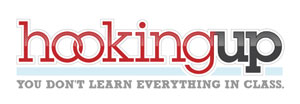 HBO is experimenting with media convergence through it’s HBOlab unit in a new web series, Hooking Up. Set in a fictional college named Bask U, the show features popular video bloggers and web celebrities. HBOlab will release the show exclusively through online video venues.
HBO is experimenting with media convergence through it’s HBOlab unit in a new web series, Hooking Up. Set in a fictional college named Bask U, the show features popular video bloggers and web celebrities. HBOlab will release the show exclusively through online video venues.
The series would emphasize content and experience over relatively low production costs, something HBO has been willing to try in the past with Project Greenlight and K Street. Both of these pseudo documentaries also leveraged star-status to help generate buzz. I expect Hooking Up will attract more visibility given advances in social media platforms and a broader reach of online video delivery.
The show’s best shot at success is each star’s ability to self promote directly to their own massive fanbases online. The sense of being approachable lends a web celebrity a distinct advantage over the contests and film stars used in previous HBO projects. Moreover, the current fanbase is already in place and quite active.
Fortunately, it sounds like the project’s success will not be measured simply on it’s ability to turn a profit, rather HBOlabs appears to have freedom to really play in the social space. Following my experience on the BMW Ramp mockumentary, I anticipate a few benefits for HBO despite the low entry costs:
- Devoted Fans
Behind-the-scenes commentaries & extra content can turn causal consumers into devoted fans, especially when a company engages them directly. Consumers that become personally invested with the stars and each other can become powerful WOM channels. Dwights Blog, Ron Moore’s Battlestar Galactica podcast and multiple Lost Podcasts are good examples. - New Audiences
HBO has an opportunity to develop new online communities around shows, storylines and set locations. They can also attract audiences from niche communities and convert them to devoted fans. - New Real Estate
HBO has an opportunity to develop new web properties with which sponsors will want to associate their own brands. - New Talent
HBOlabs can develop production and creative talent into other projects at HBO. Shows & talent can cross pollinate to generate more buzz and attract fresh audiences. We realize similar benefits at SQPN. - Generate Buzz
Free PR outlets like fans, evangelists, thought leaders and the business press help refresh HBO’s top of mind awareness and new paid subscriptions. - Smart Positioning
Companies that invest in social media are currently perceived as youthful, approachable and technically savvy.
HBOlab is already gaining popularity with Runawaybox, an interactive brand spanning multiple domains, including a behind-the-scenes blog, MySpace and multiple Youtube channels.
Hooking Up is written and directed by Sherwood “Woody” Tondrof, part of the creative talent behind “The BC“, a 2005-2006 web series spoof on Fox’s “The OC.” The BC tells the story of a troubled Boston College student who meets a kindly Jesuit priest. The show is fiction, but it effectively uses real BC students and professors and garnered national attention through a mixture of traditional and online guerrilla marketing.
TWIP Bulletin 9/13/2008
The Weekly Interactive Producer Bulletin
September 7, 2008 to September 13, 2008
# 5Intense Religious Experience with D90.
# 4A Handy Internet Procrastination Flowchart from the Dongle Extraordinaire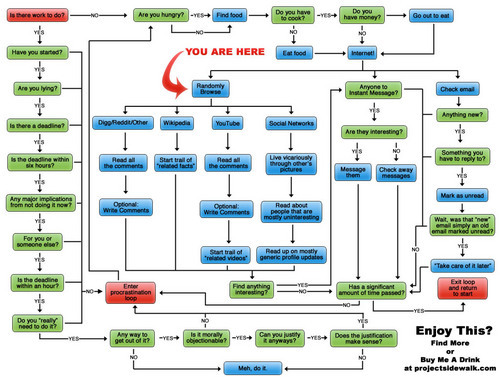
# 3Should Pepsi give some props to Wiseacre Photo?
# 2This dodgeball video from Sky High cracks me up.
This exercise is for Social & Community Managers seeking to start, build and grow their online communities.
Be sure to read the Online Community Lifecycle first!
Stage 1: Forming
Reflection: Online Community Formation
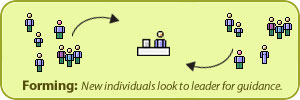
You probably have a good idea about how you’d like to steer the early stages of your web community. Ponder these questions to see if you’re on track and where you might adjust.
Have you defined how your community will operate? Have you published forum rules or comment guidelines? Do you have a privacy policy? Do you have a plan for dealing with spam, trolls and other abusive elements?
Will you allow members to self-promote in early stages? Will your leaders and mods be able to distinguish between natural self-promotion and spam posts?
What attributes reveal your management style? Approachable? Hands off?
Which best describes your approach in forming your group?
» Ready. Aim. Fire.
» Ready. Fire. Aim.
» Ready. Aim. Aim. Aim. Aim.
Who do you know that counterbalances your style and approach? How can they help?
Are you participating in your community? What are you doing to foster group participation? What are you doing that inhibits participation?
Who is emerging as a potential leader in your community? Are there any brand evangelists? Consistent contributors? Natural mediators? Do they get along well with others?
Stage 2: Storming
Reflection: Online Community Growth
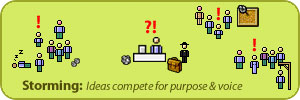
As your community vision extends to others, you inherently sacrifice messaging control. Learn from the mistakes of others, and look at the many brands handling this change successfully. Read these questions to help articulate new and persistent problems and suggest possible actions you can take.
How do you welcome new members to your community? What would a new member experience when they join your group?
Do you have infighting among members of your group? Is it healthy debate or destructive bomb-throwing?
Do you have a Troll Watch List? How will you deal with troublemakers? Which is an appropriate course of action: a public rebuke? A gentle reminder of the rules? Or do you cut to the bone and ban them from the community?
Do you have arguments spilling over from other communities on the Internet? Can you find resolution from past history? Do you accept personality clashes as inevitable?
Do “know-it-alls” squash discussion? Are they truly knowledgeable, but lack interpersonal soft skills? Can you help them add value without pissing everyone off? Or are they just jerks? Can you call in support from senior members to chastise, clarify, defend or attack?
How do you oversee member contributions? Are avatars offensive? Are you overrun with spam or offensive material? Do you invite self-policing or do you have a team of responders actively patrolling for issues or both? Do you have clear path to moderators so members can notify you of problems? Are you aware of technologies that can help you control unwanted and malicious material?
Do you have strong diplomats that value peacekeeping over healthy debate and disagreement? Are they allowing an argument enough time to play itself out? Do they send fighters to their corners too quickly?
How is your leadership personality? Can you be a bit overbearing or needy at times? Too timid? How do you respond to the ideas of others? Do you have a “brain trust” that can give you honest feedback of your performance?
Stage 3: Norming
Reflection: Habit & Tone in Your Online Community
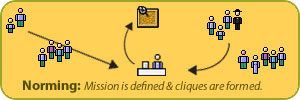
As your community matures, you will recognize healthy attachment among its members. Your community may operate fine in this stage with minor maintenance and attention. Or you might want to tighten cooperation and press for higher performance.
Can you identify sub-groups within your community? Which are good, bad or ambiguous to your goals & objectives?
Do you have any individuals that tend to cut across cliques or rise above the fray? Might they become leaders, moderators or brand evangelists for you?
What tools and methods can every member hook into? What areas need stronger collaboration?
What good habits does your group have? How can you foster them?
What bad habits does your group have? What actions or lack of action leads to those habits? What attitudes, beliefs and past “baggage” contribute to those ongoing actions?
What ideas and practices are deeply ingrained in your community? Do they really serve the purpose? Can you identify any that are harmful or inhibit performance? Are you part of the echo chamber or do you have enough distance to recognize it?
Are you transitioning from a role of director to a role of working supervisor? Are others assuming roles of leadership?
Do you need to return to a new Forming or Storming stage to shake up your community? Who can you recruit to help?
Stage 4: Performing
Reflection: Sustaining High Performance
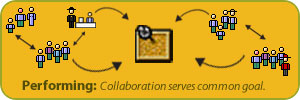
Congratulations if your community has achieved a level of high performance. Take some time to think about how you can keep it going.
Is your software keeping pace with your level of community activity?
Which social networks target your membership demographic or psychographic? Where else do your members hang out? Can you forge mutually beneficial partnerships?
Can use social media networks and user generated content platforms to expand services to existing members? Can you use these tools to boost membership?
Can you leverage Ning’s “viral expansion loop” to accelerate growth?
What tactics do you see working in other high performing communities?
Post Mortem: Transforming and Mourning
Reflection: Changes and Death of an Online Community
Your community may be on the verge of temporary or permanent transition. Consider these issues to decide if you should embrace change or pull the plug.
Have key influencers or core leaders left the group?
Are you facing burnout? Do you have time to continue leading?
Are you stuck in a perpetual Storming stage? Would it make sense to transition back to Forming or press on to Norming?
Who could potentially take over community management? Is there a stand-out leader or sub-group?
Is your advertising campaign approaching EOL? Is the community still flourishing? Do long-tail benefits justify continued community support, even without actively promoting it?
How can your community celebrate its accomplishments? Who deserves acknowledgment?
Final Thoughts
Community Managers that want to work on their community, and less time in it should study Tucker’s model of group dynamics in the context of a Social Community Lifecycle.
IT Consulting company Avanade recently polled 541 global top executives and discovered that the majority do not have a formal plan for adopting social media. This finding comes despite proven company benefits, so we can expect a few more years of wailing and gnashing teeth as evangelists from all social media denominations fight for adoption.
Here is my POV on why companies are slow to move in the social space despite the benefits. I offer a suggestion to curious company managers as well: start a simple “Social Media Lab” to explore tools and best practices.
Before asking why companies avoid social media, let’s consider a brief primer on why they should.
How can companies benefit from social media?
Thousands of blogs are devoted to this simple question. Here are a few reasons.
Better Service
Customers appreciate multiple channels of communication. By making themselves more approachable and accountable in the marketplace, companies earn the trust of new and existing customers. This can translate to a culture of listening, testimonials, good PR and higher sales.
Better Support
Public support empowers customers to resolve problems quickly and independently.
Companies like SWsoft experience tremendous growth because they introduce their customers to each other for mutual technical support. The company keeps close tabs on rising issues in their Plesk product and refines their development roadmap for new features requested by customers. SWsoft needn’t be concerned with public criticism because they have an opportunity to openly demonstrate their commitment to service. They also enjoy quick and thorough defense from evangelists. Peer reviews are very powerful for growth.
Higher Sales
Trust and accountability earned in service and support broadens a company’s target. In addition, social media can elevate service for preferred customers. For example, Dell Premier Pages helps large customers handle procurement and support, but social media introduces opportunities for lead gen, sales assistance and higher per-sale closings.
Stronger Vendor Relations
Opening lines of communication and collaboration among vendor networks increases efficiency and cuts costs. This applies to everything from fulfillment to billing and encompasses breaking news, emergencies and feedback.
Internal Collaboration
For years, companies have benefited from intranet communications: news engines, wikis, document sharing, learning management systems, trouble ticketing, etc. Social media like message boards, blogs, commenting, online ideation, social chat and UGC sharing are part of a natural evolution toward group cohesion.
According to the Avanade study, among the companies that are early adopters of social media, two thirds have experienced improved customer satisfaction. 64% report an improved reputation in the marketplace. Most reported that social media is inevitable, and 2 in 5 companies can directly associated an increase in sales with a move to using new forms of media. So, the study begs the question…
Why are companies avoiding social media?
The Avanade study cited common reasons around fear and apathy for a lack of social media integration. Company executives worry that social media will cut employee productivity. They worry about security and reliability on unproven technologies. Social media advocates claim executives don’t understand the potential of social media on customers or employees.
My experience is that social media reticence within advertising stems from three key areas.
The Timing Is Premature
We have witnessed similar hesitation in nearly every iteration of online media. Indeed, the technology adoption lifecycle paints a clear bell curve between innovative early adopters and laggards. I remember a similar argument among small businesses on why they should even publish web sites. Today, it seems, the examples of good uses of social media are coming from small businesses seeking to distinguish themselves as nimble and responsive to large competitors. It is simply a matter of time until early social media success parlays into broader adoption.
Advertising Reactionaries vs Progressives
There exists within advertising two philosophical camps: Reactionaries that cling to traditional media and progressives that tout the bleeding edge of new media. Reactionaries tend to live in the upper echelons of account, creative and media departments. Progressives are younger up-and-comers across agency ranks and most have had high-speed Internet access their entire adult lives. Reactionaries read printed versions of Advertising Age and progressives watch daily Ad Age vidcasts. A cycle of conflict ensues: progressives respond to reactionary skepticism by pushing the latest interactive trends (even if inappropriate) and reactionaries respond to the idealism of progressives by not supporting cool projects (even if appropriate). Internal strife abounds before and after work is presented to the client.
Marketing vs IT
There exists within companies a natural push-pull between Marketing and IT groups, especially around web site management. In the realm of interactive advertising, Marketing is drawn to new methods of reaching audiences despite unproven technologies, high costs and lack of resources. IT resists high implementation costs and distractions from principal duties in security, uptime and data management despite the potential benefits of a well executed campaign.
How can companies explore social media?
Nobody wants to risk undo harm to their brand. Therefore, competing groups tend to look to the market to guide their next steps. Social media tools are so new that virtually everyone waits to see which tools, platforms and best practices bubble up to mainstream. The market naturally gravitates toward proven success.
Taking a page from the Google Labs playbook, I suggest that curious companies create their own “Social Media Lab” that explores the social space. Competing groups can build a social web strategy by sharing their perspectives on risks and opportunities and performing light experiments.
Both Marketing and IT groups have individuals that tinker on the edge of new media. Marketing has people that are always entertaining new methods of reaching untapped audiences. IT has people that apply their their own sense of creativity to new technologies and platforms. Putting these people together with an expressed common goal can yield fascinating results.
While working at Power Computing, a very successful Macintosh-clone company, we experimented with several tools in the mid 1990s that precipitated the rise of social media. We devoted resources to extranet development so internal staff and partners could collaborate. We monitored public forums and listservs closely in order to engage the public directly, announce news and respond to emergencies. We eventually shared our internal support knowledge base with the public, a tool that became the basis of Apple’s online support. Each of these activities contributed to the public perception of Power Computing as young, edgy and well-intentioned, giving the company a competitive boost.
Forrester Analyst Jeremiah Owyang describes the evolution of brands on Twitter. His web strategy offers insight into any social medium the Lab wants to explore. He advocates a crawl-walk-run approach for brands curious about social media.
A Social Media Lab does not need to be a distraction. With a little concerted knowledge sharing and a playful approach to social media, companies can harness energy and interest amid small teams to realize potential for the entire company.
Links
Web Pro News Article “Majority of Companies Avoiding Social Media,” Sep 8, 2008
Coleman Parkes Research, author of the survey, “CRM and Social Media: Creating Deeper Customer Relationships.” See also: “Web Content Development and Management,” a white paper on the tension between Marketing and IT.
Avanade Press Release “Most Companies Avoid Integrating Social Media Despite Evidence of Benefits,” Sep 8, 2008
Avanade CRM & Social Media Reports from the Avanade Advisor.
Avanade Thought Leadership Series of webinars, podcasts and white papers on commercial use of social media and digital collaboration.
Although Social Media Will Normalize, Dedicated Roles and Direction Are Still Needed Forrester Analyst Jeremiah Owyang foresees natural dedicated roles as corporations define business goals and put budgets and resources towards social media.
Group Dynamics 101 for Online Community Managers
Forming, Storming, Norming and Performing
A couple years ago I took a 10-month leadership course on small group facilitation to learn about how new groups form and achieve sustainability. The lessons were geared for physical offline groups, but my experience as an online group facilitator, including one of the largest social networks on Ning, convinces me that offline group models remain intact in the realm of social media as well. Web communities are comprised of real people, so we can expect basic human behavior patterns to permeate regardless of the medium in which they communicate.
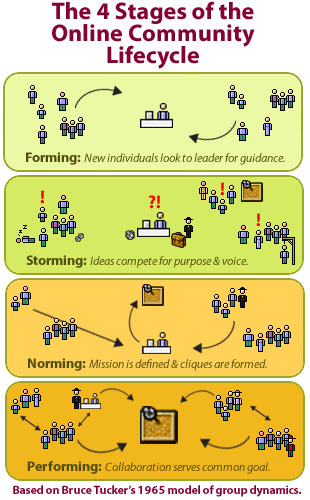
In 1965, Bruce Tucker proposed a model of group dynamics popularly known as Forming, Storming, Norming & Performing. In a nutshell, Tucker’s model encompasses several distinct stages, beginning from a group’s creation through its maturation and ultimate evolution or extinction.
Online community managers will find that Tucker’s work is still relevant today. These same stages of creation and growth are evident within all types of social media. If you moderate blog comments, forum posts, product reviews, news feedback, podcast networks or participate in social gaming or virtual worlds, Tucker’s model should be of interest to you. This is especially useful if you want insight into how your community can achieve sustainability.
The Lifecycle of Online Communities
Let’s look at each stage in sequence and consider how Tucker’s model applies to today’s online groups. As you read the descriptions, try to identify within which stage your online community currently exists. Is your community flourishing? Do you need to shift your community toward a later stage? Or retreat to an earlier one?
Update: I posted a series of reflection questions for each stage of the lifecycle.
Stage 1: Forming
The Group Is Born
In the early stages of group development, individuals rally behind a leader or core steering committee under a banner of broad challenge or opportunity. Enthusiasm is high, friendships form easily and people begin working on tasks. Everyone tends to be on their best behavior, but founding members operate independently with sense of autonomy and tend to be self-focused.
 Successful groups leaders claim a position of authority by virtue of their experience, maturity, availability or simply because they are the ones laying the ground rules. Leaders frame guidelines on how the group will function and how its members will interrelate. This may be expressly written or socially implied through mission statements, codes of conduct and “leading by example.” Sharing the principles of group dynamics among group leaders and moderators can be very helpful in preparing people to encounter situations. (wink wink nudge nudge: share this article with your social media managers…)
Successful groups leaders claim a position of authority by virtue of their experience, maturity, availability or simply because they are the ones laying the ground rules. Leaders frame guidelines on how the group will function and how its members will interrelate. This may be expressly written or socially implied through mission statements, codes of conduct and “leading by example.” Sharing the principles of group dynamics among group leaders and moderators can be very helpful in preparing people to encounter situations. (wink wink nudge nudge: share this article with your social media managers…)
In the Forming stage, group leaders should also watch for early emerging leaders. When I instructed ROTC cadets in various drill camps and leadership schools, we closely observed individuals in order to fill positions as squad leaders and flight commanders within the first few hours of training. Extroverts tend to rise because they naturally make themselves known to others, but introverts are just as capable of leading if they are prompted or invited to do so.
You probably have a good idea about how you’d like to steer the early stages of your web community. Read these questions to see if you’re on track and where you might adjust.
Stage 2: Storming
Ideas and Personalities Compete to Be Heard
Every group encounters a period of identity & self awareness, where members debate essential objectives and problems and how they should behave individually and within groups. This is also a stage where leadership authority, knowledge, style and capability is most apt to be judged as either appropriate or unsatisfactory.
 Groups can pass quickly through this stage or they can collapse for a number of reasons. If a leader abdicates their early role as guide, role model and referee, then stronger personalities are poised to set the behavioral tone. If purpose and objectives are muddled, then people will argue or undermine others to prove that their ideas are superior. “Good” people that were initially motivated, engaged and participating will leave the group.
Groups can pass quickly through this stage or they can collapse for a number of reasons. If a leader abdicates their early role as guide, role model and referee, then stronger personalities are poised to set the behavioral tone. If purpose and objectives are muddled, then people will argue or undermine others to prove that their ideas are superior. “Good” people that were initially motivated, engaged and participating will leave the group.
Another common community “soul killer” is the mouthy member that cannot help themselves from yapping. You know these people. They speak too often, for too long, and usually about issues that are irrelevant and self-serving. They overemphasize the minutia and obfuscate meaningful issues. They can make others uncomfortable by being too personal or act insensitively to others. They are not invited to speak by others, rather they tend to chime in on everything to imply deep personal wisdom, even if they just want to point out that they have no opinion on the matter. They moan, whine and grind their opponents. At the same time, these people can be overly welcoming and kind to new group members in an effort to win them to their side. Their immaturity is so evident, one is surprised to learn they aren’t a teenager (perhaps they are in netiquette terms).
If group leaders do not want to lose control of their group at such a critical stage, they need to act decisively to stifling, filibustering and flame wars. A good community manager brings a big bag of tricks with tactics in nuance, creativity, subtly and force. Like a good parent, group facilitators need to be ready to discipline, lead and teach. By applying a little parental love to your community, you can present an example of nurturing behavior amid disagreement and discord and move quickly past an otherwise painful growth spurt.
As your community vision extends to others, you inherently sacrifice messaging control. Learn from the mistakes of others, and look at the many brands handling this change successfully. Read these questions to help articulate new and persistent problems and suggest possible actions you can take.
Stage 3: Norming
Purpose, Cliques & Team Habits Form
Groups that reach the Norming stage enjoy clarity about their goals and objectives. That clarity helps to draw its members into service of the group, so harsh infighting and sabotage tends to fall away before this stage.
 Individuals promote themselves less, unless the group’s objective involves self-promotion like business networks, alliances and chambers of commerce. Even then, members support each other through introductions into spheres of influence beyond the group.
Individuals promote themselves less, unless the group’s objective involves self-promotion like business networks, alliances and chambers of commerce. Even then, members support each other through introductions into spheres of influence beyond the group.
Members in this phase naturally attach to sub-groups of similar interests and tasks. Teamwork is stronger within sub-groups and sub-groups work more seamlessly with each other. Trust is built as people get to know each other and as the group accomplishes objectives. Collaboration is built through agreement on rules and the sharing of methods and tools.
Groupthink is a hazardous risk in the Norming stage, where new ideas and creativity are stifled in favor of process and status quo. Community leaders need to caution against group denial and echo chambers by recognizing their symptoms. They can avoid groupthink by remaining neutral and inviting fresh POVs when appropriate.
Hierarchy tends to flatten out during Norming compared to earlier stages. With a clear mission, collaboration and interpersonal issues worked out, leaders are able to assume more production tasks. Conversely, team leads may be established with more authority and control passed down and shared from Forming and Storming managers.
As your community matures, you will recognize healthy attachment among its members. Your community may operate fine in this stage with minor maintenance and attention. Or you might want to tighten cooperation and press for higher performance. Reflect on your community to see where it is healthy and where it needs attention.
Stage 4: Performing
Teamwork & Efficiency Prevail
A few groups will achieve the Performing stage where everyone seems to be firing on all pistons. Milestones are accomplished and objectives are routinely met. Experience is high, so communities become a rich knowledge base.
 Teams become interdependent and work together fluidly without the drama borne from unnecessary conflict. Dissent does exist as long as it is channeled in a manner that is acceptable to the group. Supervision is minimal as people are held accountable to each other. Decision-making resembles more of a populist democracy than a dictatorship or republic. Community leaders tend to be highly participative.
Teams become interdependent and work together fluidly without the drama borne from unnecessary conflict. Dissent does exist as long as it is channeled in a manner that is acceptable to the group. Supervision is minimal as people are held accountable to each other. Decision-making resembles more of a populist democracy than a dictatorship or republic. Community leaders tend to be highly participative.
High performing teams may face circumstances that thrust themselves back to early stages. For example, the void left when early leaders leave a community can trigger a new Storming phase. I’m also reminded of the downtime caused by an explosion in the Planet’s H1 data center in Houston, an experience that sent its support forums into overdrive. Communities can experience these cycles of life over and over.
Browse the Big Boards to get a sense of what some of the largest communities on the web are doing. This is an outstanding resource for guerrilla social marketing.
Congratulations if your community has achieved a level of high performance. Take some time to think about how you can keep it going.
Post Mortem: Transforming and Mourning
Dealing with Change and Coping with Demise
Online communities are like living organisms that either adapt to internal and external changes or they will die. Think back to the big events in your life and they were almost always precipitated by change. Leaving home, starting school, starting a career, leaving a job, getting married and having kids all involve a death of sorts. One ceases to act or exist in one way when they change in another way. The same kind of death and renewal applies to groups.
I have seen leaders “kill” online communities and the reaction is not unlike real-world death. Feelings may not be as severe as losing a loved one, but members do experience a sense of loss like seeing your favorite TV show get canceled or saying goodbye to a friend that move’s away. This experience in virtual communities is not surprising considering the personal investment and real formation of human bonds.
Brand managers should consider this effect when transitioning campaigns or taking down social microsites at the end of a media flight (aka End of Life or EOL). If maintenance costs are truly inhibitive to effective ongoing community support, then the community should probably be taken offline. A diseased community can actually be harmful to a brand.
On the other hand, if long-tail benefits are evident and the group is operating at a strong Norming or weak Performing stage, the community may merit a plan for transition and ongoing maintenance, even if it only provides minimal support.
If you decide to maintain a community because participation and impressions justify the cost, then turn to your vendor partners for help in this transition. Good providers like Mango Mobile plan for EOL at the beginning of a campaigns. They are very flexible in either extending maintenance agreements or handing all assets back to the client for perpetual hosting. Another example is Blockdot in the advergaming space. They continue to support several widgets, social gaming and community applications well beyond the original EOL campaign schedule.
The life and energy of a social network benefits from early planning in the Online Community Lifecycle. Likewise, it benefits from planning at the end of life. Leaders can use Transforming and Mourning stages as an opportunity to publicly praise the group’s accomplishments. Individuals can be recognized, relationships can be acknowledged and achievements can be praised. People celebrate the birth of children and they gather to celebrate the life of those departed in death. The same kind of celebration can be introduced to the life and achievements of an online community.
Your community may be on the verge of temporary or permanent transition. Consider these issues to decide if you should change or pull the plug.
Final Thoughts
Community Managers that want to work on their community, and less time in it should study Tucker’s model of group dynamics in the context of an Online Community Lifecycle. Just as a sapling needs light, nutrients, water and fresh soil, an online community can be groomed for healthy sustainable growth.
Update: Read the accompanying article, How to Strengthen Your Online Community
Clark Howard Is Growing Up
While writing about the Online Community Lifecycle, I recalled an episode I observed years ago during the “storming” phase of the Clark Howard Message Boards. I remember one particular real estate expert who was an absolute tyrant in the community. This guy knew his field extremely well, but he had zero patience for real estate noobs and those with whom he disagreed. He offered world-class advise, but would turn on a dime into a crass name-calling bully. For the life of me, the only reason I can fathom that Clark allowed this to persist is because he is a notoriously self-admitted cheapskate that didn’t invest in proper tools and personnel to sustain a vibrant community. Unfortunately, Clark allowed his community to fester and attack each other relentlessly, and were it not for his very popular radio show and books, it surely would have failed.
I found this member’s disposition to be quite amusing in spite of the anguish he caused. He really did know his stuff, even though his tough-love modus operandi ruffled feathers. I joined the group and started a new topic entitled “Ode to [whatever is name was].” I wrote a simple sonnet a la the meter of “There once was a man from Nantucket” about this particular individual.
In an amusing and respectful way, I essentially pointed out how smart this guy was. People needed to look past his curmudgeon persona and listen to the genuine knowledge he had to offer.
The response was very positive given that it was so personal. People came forward to give the guy the credit he deserved, yet inviting him to chill out. He appreciated the gesture, other lurkers came out of the shadows and several people even wrote their own poems; very funny in a stale financial forum.
Unfortunately, Clark’s moderator got wind of the thread and, incredibly, removed it because it didn’t meet some strict (and secret) rule about never ever under any circumstances deviating from financial discussions. Shortly thereafter and ever since, newcomers are assaulted with the glaring red warning to behave and to watch out for unscrupulous behavior, negative messaging that is sure to drive them straight to the shadows of Lurker Land.
The moderator’s decision was a real shame because we had planted a fun seed of comradeship and goodwill amid a well-intentioned community. Moreover, this online brand was desperately struggling to find a kind voice that welcomed new members. It’s remarkable because if you spend 2 minutes listening to Clark, you’ll hear a very gentle and humorous tone that was in stark contrast to the vitriol people encountered on his website at that time. I think the moderator’s seemingly hip-shot decision to stamp out any fun was a serious mistake for another reason as well: Community leaders should never forget that people are actually investing themselves when they contribute content. This investment strengthens a community and develops brand evangelists. And converting lurkers to active participants should always be nurtured whenever possible.
Thankfully, Clark seems to have learned some important lessons. His team has a presence on the boards and applies more consistent moderation. New visitors can see clearly demarcated subject matters to consume content relevant to them.
Clark also does an excellent job of directing his radio listeners to his website during his “Trash Clark” segment where he invites people to log on and leave feedback in his “Clark Stinks” forum. This strategy accomplishes two key objectives simultaneously. (Note: I hesitate to say “strategy” because I believe Clark’s success is in large part because he has a true servant’s heart. He cares deeply about his listeners.) First, by promoting his message boards, he is encouraging people to participate beyond listening and lurking. I’d wager his website enjoys long length-of-stays and very low bounce rates. It’s prime real estate for his radio advertisers which presumably could generate more revenue for some technology improvements.
Second, Clark provides a vehicle for people to give him direct public feedback, which amplifies his nice-guy approachable image. Few people actually bash Clark, but his gesture is very smart.
While part of this online community feels as though it’s clinging to adolescence, at least it has matured beyond puberty. Clark’s radio convergence and enthusiastic team shows signs of even greater potential.